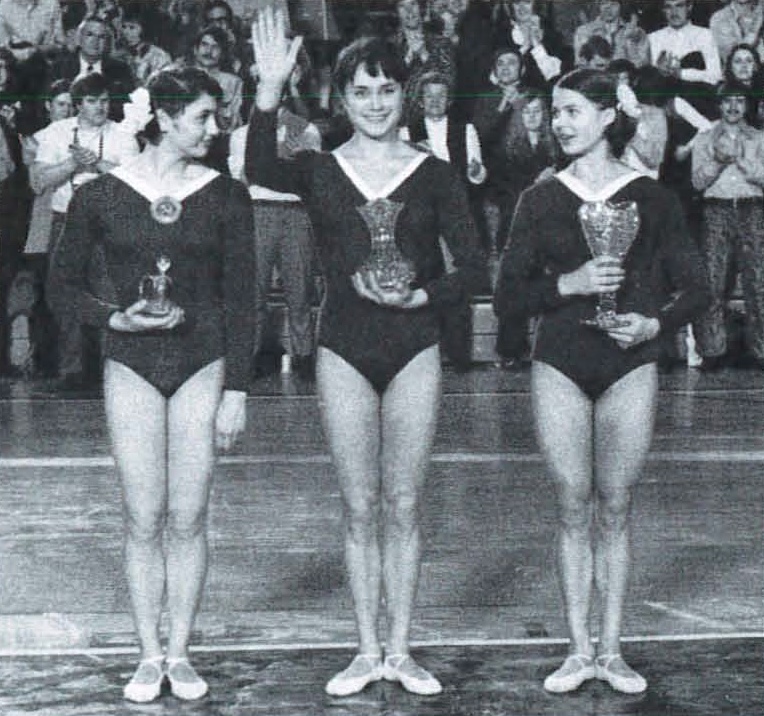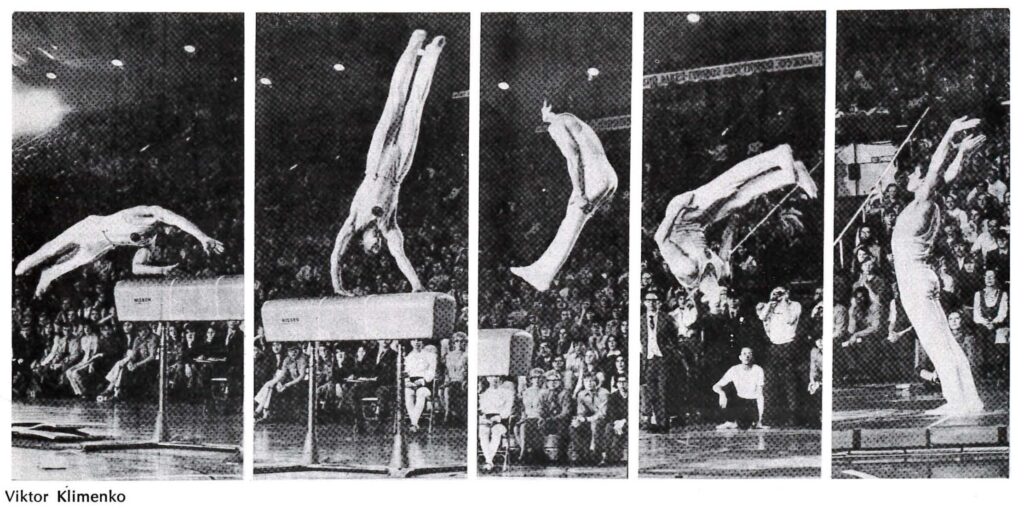In 1969, the United States Gymnastics Federation invited the Soviet Union to its World Cup, but the Soviet Union did not attend. In 1971, the winds changed, and the Soviet Union traveled to the U.S. for dual meets at Penn State and Temple University.
What follows are remarks on the competition at Penn State (February 5 and 6, 1971).

Source: Madamoiselle Gymnast, March/April 1971
Note: It should be noted that this gymnastics competition was not the first sporting event between the two countries during the Cold War. In 1962, for example, there was a U.S. vs. USSR track and field dual meet. In 1961, Soviet gymnasts toured the United States, and U.S. gymnasts competed in the Soviet Union.
Quick Links: Results | Competition Coverage | Videos | Appendix: Results and Videos from the Temple University competition
Results
Men’s Results
Team
| FX | PH | SR | VT | PB | HB | Total | |
| USA | 36.90 | 36.90 | 37.20 | 36.80 | 37.10 | 37.05 | 221.95 |
| USSR | 37.20 | 38.00 | 38.40 | 37.90 | 37.05 | 37.35 | 225.90 |
All-Around
| Gymnast | Country | FX | PH | SR | VT | PB | HB | Total |
| 1. Klimenko | URS | 9.50 | 9.60 | 9.60 | 9.70 | 9.60 | 9.70 | 57.70 |
| 2. Bogdanov | URS | 9.60 | 9.45 | 9.50 | 9.55 | 9.40 | 9.60 | 57.10 |
| 3. Avener | USA | 9.40 | 9.60 | 9.30 | 9.10 | 9.35 | 9.50 | 56.25 |
| 4. Maleev | URS | 8.95 | 9.30 | 9.50 | 9.30 | 9.50 | 9.40 | 55.95 |
| 5. Weiss | USA | 9.05 | 8.75 | 9.35 | 9.20 | 9.65 | 9.40 | 55.40 |
| 6. Mitchell | USA | 9.25 | 8.55 | 9.30 | 9.25 | 9.20 | 9.15 | 54.70 |
| 7. Litow | USA | 9.20 | 9.25 | 9.05 | 8.95 | 8.90 | 9.00 | 54.35 |
| 8. Culhane | USA | 9.00 | 9.30 | 9.25 | 9.25 | 8.65 | 8.80 | 54.25 |
| 9. Ananskikh | URS | 8.80 | 9.40 | 9.30 | 8.95 | 8.55 | 5.00 | 50.00 |
| 10. Voronin | URS | 9.05 | 9.55 | 9.80 | 9.35 | * | 8.65 | 46.50 |
Women’s Results
Team
| Country | VT | UB | BB | FX | Total |
| USSR | 37.90 | 37.70 | 37.30 | 38.25 | 151.15 |
| USA | 37.50 | 36.75 | 36.55 | 38.10 | 148.90 |
All-Around
| Gymnast | Country | VT | UB | BB | FX | Total |
| 1. Tourischeva | URS | 9.60 | 9.65 | 9.40 | 9.70 | 38.35 |
| 2. Voronina | URS | 9.50 | 9.40 | 9.40 | 9.55 | 37.85 |
| 3. Sikharulidze | URS | 9.30 | 9.35 | 9.45 | 9.35 | 37.45 |
| 4. Karaseva | URS | 9.40 | 9.30 | 8.90 | 9.65 | 37.25 |
| 5. Cluff | USA | 9.35 | 9.05 | 9.15 | 9.45 | 37.00 |
| 5. Moore | USA | 9.20 | 8.95 | 9.25 | 9.60 | 37.00 |
| 7. Rigby | USA | 9.40 | 8.35 | 9.65 | 9.50 | 36.90 |
| 8. Petrik | URS | 9.40 | 9.25 | 9.05 | 9.05 | 36.75 |
| 9. Pierce | USA | 9.50 | 9.40 | 8.50 | 9.20 | 36.60 |
| 10. Chace | USA | 9.25 | 9.35 | 8.40 | 9.55 | 36.55 |
Competition Coverage
Men’s
The logistics changed at the last minute, and as a result, the top U.S. men did not compete. Only a team of Penn State gymnasts did.
After many invitations, personal contacts, telegrams and frustrations, the Russian Gymnastic team of 5 men and 5 women along with officials arrived in the USA on February 2nd for a brief USA tour of ten days. What had been originally planned as a 21-day cross country tour with stops at Penn State, Chicago, Denver, and Los Angeles, was vetoed by the Russian home office down to a competition at Penn State and Temple (the Temple visit was a last-minute booking to take advantage of their brief stay on the east coast). In the original schedule the USSR men were to compete against a Penn State team (including alumni) and the official USSR vs USA match was to be in Los Angeles with the other stopovers as regional competitions and exhibitions.
Because the USGF could not be sure the Soviet team would arrive (even up to one week before the Penn State Competition), it was impossible to arrange a USA National team effort, therefore the Penn State Meet became the official USA-USSR Match. The Penn Staters did a great job, and came so close to winning that it would be interesting to speculate on the outcome of a USA-USSR competition with Sakamoto, Allen, Tickenoff and others of the World Games team taking part.
Modern Gymnast, March 1971
Bogdanov was the most impressive of the male gymnasts.
To this author, Bogdanov was the most impressive of the Russians and may well be their next “number one”. His floor exercise was outstanding highlighted by dynamic tumbling (he opened with a double back that was landed standing up).
Modern Gymnast, March 1971
Note: At the time, many gymnasts performed “circus” double backs, meaning they immediately did a backward roll upon landing the double back. So, it was a big deal that Bogdanov landed upright. (“Circus double back” was the term used in the United States at the time.)
Less than 4 months after Tsukahara debuted his eponymous vault, Klimenko was competing the same vault, and it was a highlight of the meet.
[Klimenko’s] cartwheel on the horse with piked back salto off is quite exciting and scored a 9.7.
Modern Gymnast, March 1971

Women’s Competition
Vault wasn’t anything special. Mostly Yamashitas.
Nothing really new shown here, which was disappointing. Many Yamas’ and a couple of twists in and off but no outstanding vault. It seems to this author that we [i.e. the U.S. women] still don’t really commit ourselves in this event (run!!). When we change pace, it’s a deceleration — for the Russians it always appears to be an acceleration.
Madamoiselle Gymnast, March/April 1971
The Soviet gymnasts were striving to make their beam routines as fluid as their floor routines.
Routines tended to be stop and go (jerky) rather than the kind of smooth flow seen in free exercise which is applicable to beam. According to the Russian coach, they are working toward this kind of expression on the beam as well as higher overall difficulty.
Madamoiselle Gymnast, March/April 1971
Sikharulidze did a front aerial on beam.
While it wasn’t the first aerial walkover, it was done spectacularly.
Sikharulidze – one hand front walkover, mount – handstand front walkover, aerial front (really stuck – it better be!), tinsica, back handspr.-back tuck off
Madamoiselle Gymnast, March/April 1971
The Soviets were the epitome of showmanship on floor exercise.
The Russian women’s tumbling has come a long way. Our American girls dominated the front tumbling sequences with some real fine work. To this observer these U.S.S.R. ladies epitomize the tops in floor work (composition and execution). Their sense of drama and showmanship is simply terrific.
Madamoiselle Gymnast, March/April 1971
Tourischeva was rumored to have a 1.5 twist.
Turistcheva has a 1 1/2 twist.
Madamoiselle Gymnast, March/April 1971
Videos
At the time of writing, there are only videos of the women’s competition at Penn State on YouTube. There are videos of the men’s competition at Temple, which you can find in the appendix.
Below, you can find the aforementioned videos, as well as a few highlighted routines.
Rigby’s uneven bars dismount.
In the late 1960s and early 1970s, gymnasts were trying to figure out how to perform saltos off the uneven bars. At the 1968 Olympics, Tanac performed her slap back and Skleničková tried a cast-away front. In 1969, Olga Korbut was performing her famous dismount: a front sole circle to a layout off the high bar.
Well, in 1971, Rigby tried a toe-on front. It’s the same dismount that Klaus Köste would use at the 1971 European Championships, where he won the gold medal.
Here’s Rigby’s attempt during warm-ups:
And her toe-on front salto in the competition:
Note: This was not the first time a U.S. gymnast performed this dismount. Doris Brause had performed it in 1959, but she did hers out of a clear hip:
To exemplify this, many readers will remember the big dismount Tom Maloney, via national television, glibly called a “Rigby.” With no discredit to Cathy intended, the first underswing front sommi uneven bar dismount was first executed by Doris Fuchs in 1959. ln fact she did it the hard way—from a free hip circle instead of a sole circle.
Gymnast, Feb. 1972
Reminder: In 1959, the uneven bars were essentially a set of parallel bars, so it’s impressive that Brause was able to perform a front salto. More on the apparatus norms here.
On uneven bars, you can see Kim Chace’s precursor to the straddled Pak salto.
You can see Sikharulidze’s exceptional aerial front walkover in this video.
Note: I have commented on several of the Soviet gymnasts’ routines in posts about the 1969 European Championships and the 1970 World Championships.
Appendix: The Competition at Temple
The New York Times (Feb. 10, 1971) reported the results from the competition at Temple University.
Men’s All-Around
- Klimenko, URS, 57.75
- Maleev, URS, 56.00
Floor
- Klimenko, URS, 9.50
- Crosby, USA, 9.45
- Maleev, URS, 8.95
Ananskikh, URS, 8.95
Pommel Horse
- Voronin, URS, 9.60
- Klimenko, URS, 9.55
- Maleev, URS, 9.40
Ananskikh, URS, 9.40
Rings
- Klimenko, URS, 9.65
- Maleev, URS, 9.40
- Bogdanov, URS, 9.30
Vault
- Klimenko, URS, 9.60
- Ananskikh, URS, 9.50
- Crosby, USA, 9.40
Parallel Bars
- Klimenko, URS, 9.80
- Bogdanov, URS, [score not listed]
- Ananskikh, URS, 9.40
Maleev, URS, 9.40
High Bar
- Klimenko, URS, 9.65
- Bogdanov, URS, 9.60
- Maleev, URS, 9.50
Women’s All-Around
- Tourischeva, URS, 38.90
- Sikharulidze, URS, [score not listed]
Vault
- Tourischeva, URS, 9.75
- Voronina, URS, 9.60
- Pierce, USA, 9.55
Uneven Bars
- Tourischeva, URS, 9.80
- Voronina, URS, 9.60
- Moore, USA, 9.50
Petrik, URS, 9.50
Balance Beam
- Tourischeva, URS, 9.60
- Petrik, URS, 9.50
- Cantwell, USA, 9.45
Floor Exercise
- Tourischeva, URS, 9.75
- Karaseva, URS, 9.65
Moore, USA, 9.65
Videos
You can watch the competition at Temple University through this series of videos: